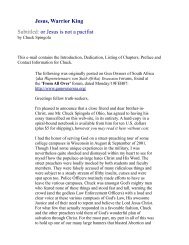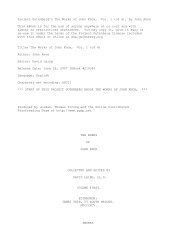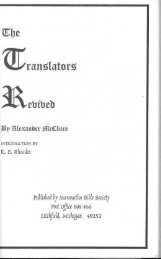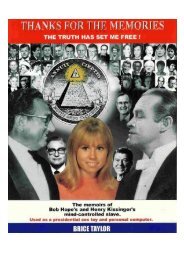THE PINK SWASTIKA - Shattering Denial
THE PINK SWASTIKA - Shattering Denial
THE PINK SWASTIKA - Shattering Denial
You also want an ePaper? Increase the reach of your titles
YUMPU automatically turns print PDFs into web optimized ePapers that Google loves.
ethic, the Maccabees did not vanquish Greek philosophy as a rival social force. Of the two<br />
irreconcilable belief systems, the Judeo-Christian one would prevail, allowing the development of what<br />
we know today as Western culture; yet Hellenism survived.<br />
Adolf Brand and the “Community of the Elite”<br />
One of the earliest leaders of the masculine homosexual counter-movement in Germany, himself a<br />
Hellenist, was Adolf Brand. In 1896, one year before Magnus Hirschfeld formed the Scientific-<br />
Humanitarian Committee, young Adolf Brand began publishing the world’s first homosexual serial<br />
publication, Der Eigene (“The Elite”). [The word Eigene, eye'-gen-eh, can be roughly translated<br />
“queer,” which may shed some light on the derivation of this term in English, but we have chosen the<br />
translation used most often by historians because it emphasizes the elitist philosophy of Der Eigene's<br />
authors.]<br />
Besides being militantly pro-homosexual, Der Eigene was racist, nationalistic and anti-Semitic.<br />
Mosse writes,<br />
The use of racism to gain respectability was a constant theme of the first homosexual journal in<br />
Germany, Der Eigene...Even before the paper published a supplement called Rasse und schonheit<br />
(Race and Beauty) in 1926, Germanic themes had informed much of its fiction, as well as images of<br />
naked boys and young men photographed against a background of Germanic nature. One poem, written<br />
by Brand himself and entitled, “The Superman,” praised manliness, condemned femininity, and toyed<br />
with anti-Semitism, apparently because of the poet’s quarrel with Magnus Hirschfeld, a rival for<br />
leadership of the homosexual rights movement (Mosse:42).<br />
Brand’s stated market for Der Eigene was men who “thirst for a revival of Greek times and Hellenic<br />
standards of beauty after centuries of Christian barbarism” (Brand in Oosterhuis and Kennedy:3).<br />
In 1903 Brand was briefly jailed as a child pornographer for publishing pictures of nude boys in the<br />
magazine, but nevertheless Der Eigene remained in publication until 1931, peaking at over 150,000<br />
subscriptions during the years of the Weimar Republic [1919-1933] (Mosse:42). In addition to Der<br />
Eigene, Brand published a satirical journal Die Tante (”The Fairy” or “The Auntie”) which often<br />
ridiculed Hirschfeld and his assistants (Oosterhuis and Kennedy:6).<br />
On May 1, 1902, Brand and two pederasts, Wilhelm Jansen and Benedict Friedlander, formed the<br />
Gemeinschaft der Eigenen (“Community of the Elite”). Its leading theorist was Friedlander<br />
(1866-1908), author of Renaissance des Eros Uranios (“Renaissance of Uranian Erotica”), a 1904<br />
publication which featured a picture of a Greek youth on the cover. Friedlander wrote that the<br />
Community wanted to carry out the goals of the lesbian and radical feminist Dr. Helene Stocker who<br />
wanted German society to revert to pagan values. Friedlander writes,<br />
The positive goal...is the revival of Hellenic chivalry and its recognition by society. By chivalric love<br />
we mean in particular close friendships between youths and even more particularly the bonds between<br />
men of unequal ages (B. Friedlander:259).<br />
According to James Steakley in The Homosexual Emancipation Movement in Germany:<br />
The Community looked to ancient Greece and Renaissance Italy as model civilizations and argued that









